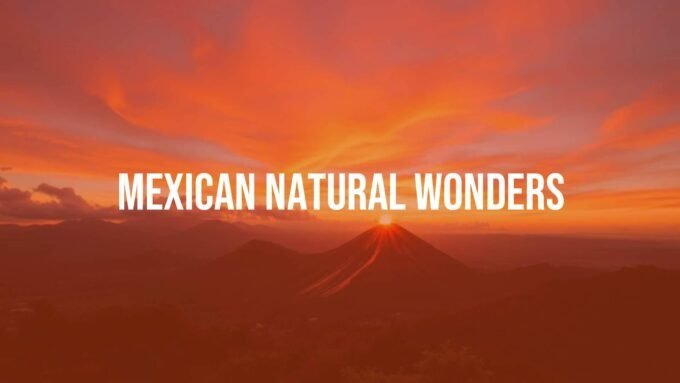Mexico is known for its rich culture, delicious food, and beautiful scenery. Central to all of this are its mountain regions, which shape the country in many ways. With more than 47,500 named mountains, these highlands influence Mexico’s weather, plants and animals, and even its history and culture. From deep canyons in the north to the volcanic peaks in the south, Mexico’s mountain ranges offer a wide range of landscapes, making the country one of the most diverse places in the world when it comes to landforms.
These mountains are not just piles of rock; they help decide where rivers run, how the climate changes from place to place, and support traditional Indigenous cultures. They are home to many different species and show the history of people adapting to tough environments. To really understand Mexico, you have to know its mountains.

Main Features of Mexico’s Mountain Ranges
The mountain systems in Mexico are large and complex. The most important is the Sierra Madre System, running through much of the country and joining many different natural and cultural areas. The ranges are connected, not isolated, and they affect weather, break up the climate into smaller zones, and provide pathways for animals and plants.
There are many types of mountains in Mexico, from tall, snowy volcanoes to smaller, forested hills. This makes the environment very different even between places that are close to each other. Changes in height, location, and closeness to the sea all combine to create deserts, forests, and everything in between within Mexico’s borders.
Where Are the Mountains Located?
Mountains can be found all across Mexico’s 1.9 million square kilometers (about 761,600 square miles), making Mexico the 13th largest country in the world. The ranges reach from the north, near the United States, down to Guatemala and Belize in the south. Nearly every state in Mexico, including Mexico City, has some kind of mountain area.
The shape of Mexico, with peninsulas and plateaus, is largely defined by these mountain systems. For example, the Baja California Peninsula is separated from the rest of the country by the Gulf of California. Its ranges, part of the Peninsular Ranges, are unique and support their own types of life. The central parts of Mexico are bordered by the Sierra Madre ranges, making deep valleys and plateaus-a landscape seen all over the country.
How Mexico’s Mountains Formed
The shapes and sizes of Mexico’s mountains come from millions of years of changes due to shifting plates below the Earth’s surface. Mexico sits on several major tectonic plates, making it a hot spot for earthquakes and volcanoes, which constantly reshape its land.
The country is part of the Pacific Ring of Fire, known for lots of earthquakes and eruptions. This location gives Mexico a landscape that is both beautiful and full of change, showing the strong forces at work under the ground.
How Were Mexico’s Mountains Made?
Mexico’s major mountain ranges were mostly formed by subduction-when one tectonic plate moves under another. The Trans-Mexican Volcanic Belt, for example, was created as the Cocos Plate went under the North American Plate. This made magma (molten rock) rise, creating volcanoes and new peaks over time.

Other ranges, such as the Sierra Madre Occidental and Sierra Madre Oriental, were shaped by uplifting and faulting, along with erosion over millions of years. The Sierra Madre Occidental has eroded from an ancient plateau made mostly of hardened lava. The Sierra Madre Oriental is mostly made of rock from the Cretaceous period, which was lifted and folded during tectonic movements. These different origins mean the mountains have varied looks and mineral resources, such as gold and silver in the west and zinc, lead, and copper in the east.
Living Volcanoes and Earthquakes
Mexico’s mountains are still changing today, with active volcanoes and regular earthquakes. The Trans-Mexican Volcanic Belt has many volcanoes, including famous ones like Popocatépetl and Pico de Orizaba, which are still active. Popocatépetl, near Mexico City, erupts frequently, often sending out ash and gases.
Earthquakes also happen often because the tectonic plates are always moving. While earthquakes can sometimes cause damage, they are a normal part of how the land is shaped and why the area is so mountainous. The natural benefits of these changes include volcanic soils, which are great for farming and support many plant and animal species.
Main Mountain Ranges in Mexico
Mexico’s landscape owes much to its many mountain ranges. Each range has its own features, history, and importance for plants, animals, and local people. Some of the best known mountain systems include:
-
Sierra Madre Occidental
This range runs from the U.S. border to central Mexico and is known for its tall peaks and deep gorges, such as Copper Canyon in Chihuahua-deeper and larger than the Grand Canyon. The area was formed from ancient lava flows and is famous for gold and silver mines, pine and oak forests, and as the homeland of the Tarahumara people. -
Sierra Madre Oriental
This range follows the Gulf of Mexico coastline and has tall cliffs, green valleys, and big caves in limestone rocks. The range started to form around 23 million years ago and is rich in metals like zinc, lead, and copper. It also has many sites from old Native cultures. -
Sierra Madre del Sur
Located on the southern Pacific coast, this range has very tough ground and thick forests. It’s known for a wide variety of plants and animals, plus many local Indigenous groups such as the Mixtec and Zapotec. Its valleys have sometimes been places for hiding during wars. -
Sierra Madre de Oaxaca
Found mainly in Oaxaca but also in Puebla and Veracruz, this range is made up of steep hills and deep valleys with many different types of environments, including cloud forests and dry areas. It’s home to several Indigenous communities who preserve their traditional languages and customs. -
Sierra Madre de Chiapas
This range is mostly in Chiapas, with parts going into Central America. It includes volcanic peaks like Tacaná Volcano, which is still active, and cloud forests with rare animals like the quetzal and tapir. Ancient Maya ruins are also found here. -
Trans-Mexican Volcanic Belt (Cordillera Neovolcanica)
Stretching from coast to coast through central Mexico, this is one of the world’s most active volcanic zones. It has the highest mountains in Mexico, including Pico de Orizaba, Popocatépetl, and Iztaccíhuatl. Volcanic soils here are great for farming, and the area is important for supplying water to much of the country. -
Peninsular Ranges of Baja California
These mountains run the length of Baja California, joining desert with the sea. They include the Sierra de Juárez, Sierra de San Pedro Mártir (with the region’s highest point, Picacho del Diablo), Sierra de la Giganta, and Sierra de la Laguna. Despite dry weather, taller areas have pine forests, and the southernmost parts have a mix of desert and tropical life.

Other important ranges include the Sierra Gorda (a lush area with endangered species), Sierra de los Tuxtlas (a volcanic area in Veracruz with rainforest and unique wildlife), and the Sierra Tarahumara (home to Copper Canyon and the Tarahumara people). Smaller, less known ranges like Sierra del Tigre and Sierra de Tamaulipas also add to Mexico’s varied mountain scenery.
Mexico’s Tallest and Most Famous Mountains
Many of Mexico’s highest peaks are volcanoes-some active, some dormant. These mountains are important parts of the landscape and have cultural and ecological importance. Climbing them attracts adventure-lovers from all over the world.
| Peak | Type | Location | Height (m/ft) | Status |
|---|---|---|---|---|
| Pico de Orizaba (Citlaltépetl) | Stratovolcano | Puebla/Veracruz | 5,636 m / 18,491 ft | Highest in Mexico, Active |
| Popocatépetl | Stratovolcano | México/Morelos/Puebla | 5,426 m / 17,802 ft | Very Active |
| Iztaccíhuatl | Stratovolcano | Puebla/México State | 5,230 m / 17,159 ft | Dormant |
| Nevado de Toluca | Extinct Volcano | México State | 4,680 m / 15,354 ft | Extinct |
| Sierra Negra | Peak | Puebla | 4,640 m / 15,059 ft | |
| La Malinche | Dormant Volcano | Puebla/Tlaxcala | 4,420 m / 14,560 ft | Dormant |
| Cofre de Perote | Shield Volcano | Veracruz | 4,282 m / 14,049 ft | Extinct |
| Nevado de Colima | Stratovolcano | Jalisco | 4,260 m / 14,009 ft | |
| Tacaná Volcano | Active Volcano | Chiapas/Guatemala | 4,060 m / 13,343 ft | Active |
Many of these peaks stand out not just for height, but because they rise alone or far from other tall peaks. For example, Pico de Orizaba is also the most prominent and isolated in Mexico. Other places, like Picacho del Diablo in Baja California, offer outstanding views and unique ecosystems, sitting more than 3,000 meters above sea level in a desert region.
Diversity of Life in Mexico’s Mountains
The mountain regions are home to an amazing variety of plants and animals. The World Wildlife Fund lists nearly 50 ecoregions and 9 biomes across the country, much of this richness thanks to the mountains. Different heights and weather bring about everything from dry shrublands to rain-soaked cloud forests, letting unique species evolve. Many animals and plants in Mexico’s mountains can’t be found anywhere else.
Pine, Oak, and Cloud Forests
At higher elevations, there are large forests of pine, oak, and fir, as well as cloud forests. These habitats are rich in wildlife and support rare species such as jaguars, pumas, and millions of monarch butterflies, which gather in some areas each winter.

- Pine-Oak Forests: Found in ranges like the Sierra Madre de Oaxaca and parts of the Trans-Mexican Volcanic Belt.
- Cloud Forests: Wet, foggy forests with moss, ferns, and lots of epiphytes, providing shelter to many animals.
Broadleaf Forests and Dry Forests
Lower areas, especially in the south and central parts of Mexico, have broadleaf forests, either wet or dry depending on rainfall. These support monkeys, crocodiles, jaguars, deer, wolves, and more.
- Moist forests are home to trees like mahogany and cedar and have lots of animal life.
- Dry forests see less rain, but still have many kinds of plants and bats, coyotes, and wolves.
Deserts and Grasslands
North Mexico and Baja California have deserts full of tough shrubs and cacti. Despite being very dry and hot, these areas still support life such as pronghorn, golden eagles, and special rodents.
Biodiversity Hotspots
Many of Mexico’s mountain zones are global biodiversity ‘hotspots’, full of species found nowhere else. For instance, the Sierra Madre del Sur is especially rich in wildlife, and the mountains in Chiapas have rare birds and mammals. Because of this, protecting these areas matters not just for Mexico, but for the whole world.
Mountains and the Environment
Mexico’s mountains play important roles:
- Climate: They shape local and regional weather, producing rain on one side and dryness on the other.
- Water Supply: They act like “water towers,” catching rain and feeding rivers, supplying cities like Mexico City with fresh water.
- Biodiversity Corridors: Mountains let species move and mix, especially important as the climate changes. Monarch butterflies, for example, depend on certain mountain paths during their migration.
- Carbon Storage: The forests in the mountains hold large amounts of carbon, helping limit climate change.
Major Environmental Issues
Climate change, deforestation, and mining threaten these environments. Higher temperatures force animals to move up the mountains, sometimes running out of places to live. Cutting down forests for farming damages habitats and watersheds. Good conservation management is needed to help these mountain areas survive.
Human Life and Culture in the Mountains
People have lived in and around Mexico’s mountains for thousands of years. Great Indigenous cultures like the Olmecs, Aztec, and Maya flourished near or in these highlands. The Tarahumara, Mixtec, and Zapotec still keep traditional ways of life in some mountain areas. The mountains also hold ancient ruins, such as Bonampak in Chiapas.

Even after Spanish colonization changed the region, many Indigenous groups have kept their customs and languages. Today, the mountains remain important for farming, mining, and especially tourism-people come from around the world to see the scenery, hike, or learn from local traditions.
Cities and Mountains
Many of Mexico’s big cities are located near mountains or in mountain valleys, taking advantage of resources and natural defenses. But being located among mountains also brings challenges, including earthquakes and complex water management.
- Mexico City: Established in a valley surrounded by high peaks like Popocatépetl and Iztaccíhuatl, faces challenges from earthquakes and water supply.
- Guadalajara: Near the Sierra Madre Occidental, benefits from the local environment and is a hub for culture and business.
- Monterrey: Sits at the foothills of the Sierra Madre Oriental, its landscape shaped by famous mountains.
- Puebla: Close to several volcanoes, its history, culture, and economy have been shaped by its location.
Outdoor Activities in the Mountains
The mountain areas are great for adventure travel and outdoor sports. Many national parks protect these areas, making them accessible for hiking, climbing, and wildlife watching.
- Pico de Orizaba National Park: Famous for mountaineering, especially between October and March. The climb is challenging and requires experience.
- Izta-Popo Zoquiapan National Park: Close to Mexico City, has hiking trails with views of Popocatépetl and Iztaccíhuatl. Climbers often attempt to summit Iztaccíhuatl, as Popocatépetl is closed due to volcanic activity.
- Sumidero Canyon National Park: Features a deep canyon in Chiapas. Most people visit by boat, observing the high cliffs and wildlife.
- Basaseachic Falls National Park: Located in Chihuahua, this park has Mexico’s second-highest waterfall and many forested hiking trails.
Ecotourism is growing quickly, with activities such as birdwatching, animal tracking, visiting archaeological sites, and guided hikes all helping to support local communities and conservation.
Comparing Mexico’s Mountain Areas
| Region | Land Features | Typical Climate | Main Cultures/Economy |
|---|---|---|---|
| Northwest (Sierra Madre Occidental, Baja California) | High, dry mountains, deep canyons, deserts | Hot, dry; pine and oak in high areas | Mining, traditional Indigenous, tourism |
| East (Sierra Madre Oriental) | Cliffs, caves, limestone, valleys | More rain; forests and caves | Mining, agriculture, historic sites |
| Central (Trans-Mexican Volcanic Belt) | Volcanoes, plateaus, fertile soils | Moderate, ideal for farming | Big cities, industry, farming |
| South (Sierra Madre del Sur, Oaxaca, Chiapas) | Very rugged, cloud/tropical forests | Wet, lush, lots of rain | Traditional Indigenous, crafts, ecotourism |
Each area is shaped by different environments and people. In the north, communities like the Tarahumara have deep roots. Central areas are home to some of the nation’s biggest cities and economic centers. In the south, Indigenous cultures and traditional ways of life are still strong.
Conclusion: The Importance of Mexico’s Mountains
Mexico’s mountain regions are a key part of what makes the country unique. They control the water supply, offer a home to many rare animals and plants, and act as the center of many local cultures. As places where ancient traditions meet dramatic natural beauty, they attract adventurers, nature lovers, and anyone interested in history. Continued care-protecting forests, managing development, and including local people-will help keep Mexico’s mountains healthy for generations to come.














Leave a comment